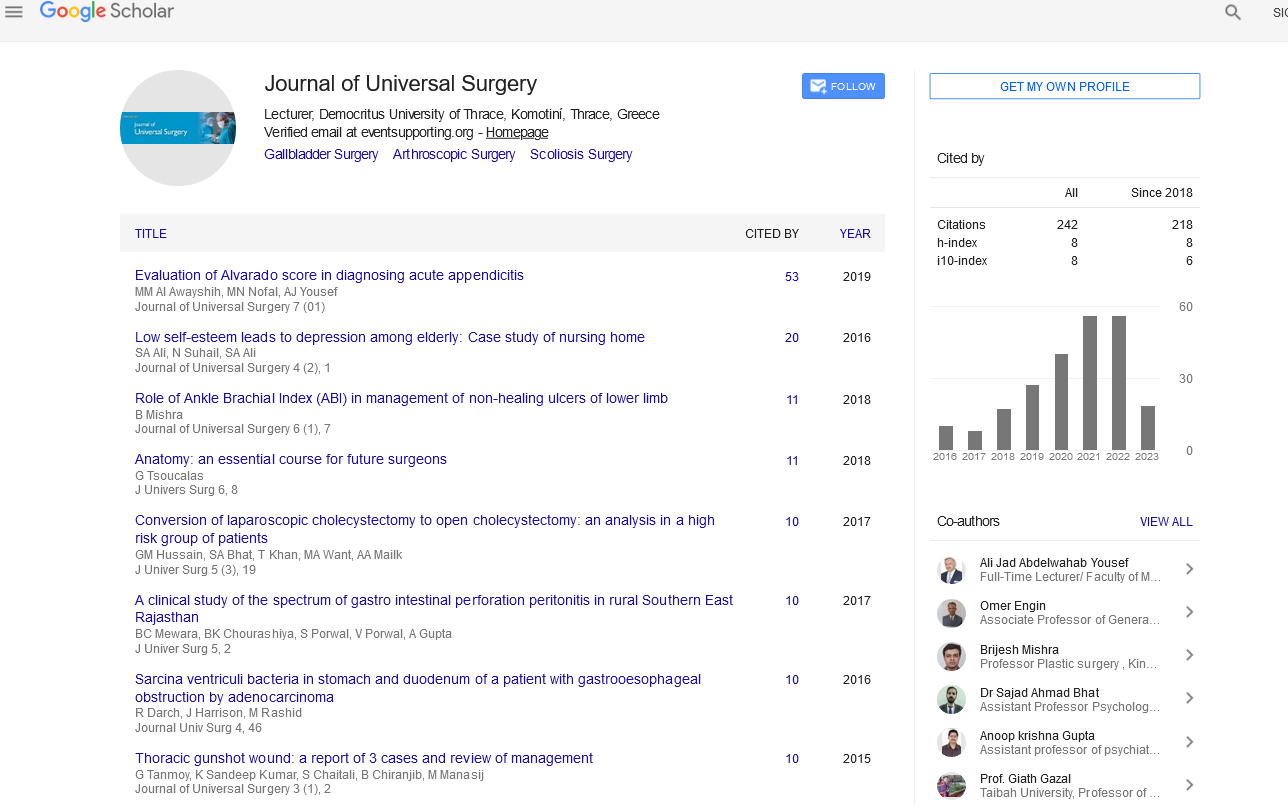Perspective - (2023) Volume 11, Issue 5
Open heart surgery: A life-saving procedure
Alex Cammel*
Department of Cardiac Surgery, University of Maui, Hawaii, USA
*Correspondence:
Alex Cammel, Department of Cardiac Surgery, University of Maui, Hawaii,
USA,
Email:
Received: 04-Sep-2023, Manuscript No. ipjus-23-14206;
Editor assigned: 07-Sep-2023, Pre QC No. P-14206;
Reviewed: 21-Sep-2023, QC No. Q-14206;
Revised: 03-Oct-2023, Manuscript No. R-14206;
Published:
19-Oct-2023
Introduction
Open-heart surgery is a medical marvel that has saved
countless lives by treating a wide range of cardiac
conditions. This procedure is typically reserved for cases in
which less invasive treatments are not viable, making it a
critical option for patients with severe heart problems.
Description
Indications for Open-heart surgery
There are several heart conditions that may necessitate
open-heart surgery, including:
Coronary artery disease: When the coronary arteries
become narrowed or blocked due to a buildup of
plaque, open-heart surgery may be required to bypass the
obstructed vessels or perform angioplasty with stent
placement.
Valvular heart disease: Conditions such as aortic stenosis,
mitral regurgitation, and other valve-related issues may
necessitate valve repair or replacement through open-heart
surgery.
Congenital heart defects: Some individuals are born
with structural abnormalities in their hearts, which may
require surgical correction.
Aortic aneurysm: A weakened and enlarged aorta can lead
to life-threatening complications. Open-heart surgery may
be needed to repair or replace the aortic wall.
Heart transplant: In cases of severe heart failure, a heart
transplant may be the only option, requiring open-heart
surgery to remove the diseased heart and replace it with a
healthy donor heart.
The open-heart surgery procedure
Open-heart surgery is an intricate and highly regulated
procedure that typically follows these general steps:
Anesthesia: The surgical team administers general
anesthesia to induce a deep sleep, ensuring that the
patient feels no pain during the surgery.
Sterilization and monitoring: The surgical area is
thoroughly sterilized, and the patient's vital signs are
closely monitored throughout the procedure.
Incision: A long incision is made down the middle of the
chest, often referred to as a sternotomy, to access the heart.
Cardiopulmonary bypass: A heart-lung machine
is employed to take over the pumping of blood and
oxygenation of the body's organs while the heart is
temporarily stopped. This allows the surgical team to
work on the heart without compromising the patient's
circulatory system.
Heart surgery: Depending on the specific condition being
treated, the surgeon will perform the necessary repairs or
replacements. For coronary artery disease, bypass grafts
are created to bypass blocked arteries. For valve issues,
the damaged valve may be repaired or replaced. In cases
of congenital defects, the structural abnormalities are
corrected.
Closing the chest: After the necessary repairs are completed,
the heart-lung machine is gradually phased out, and the
heart is restarted. The chest is then closed using sutures or
staples.
Recovery: The patient is taken to the Intensive Care Unit
(ICU) for close monitoring and recovery. It may take
several days to a week for the patient to fully recover from
the surgery.
Risks and complications
Open-heart surgery is a major surgical procedure, and
like any surgery, it carries certain risks and potential
complications. Some of these risks include:
Infection: There is a risk of infection at the surgical site or
within the chest cavity.
Bleeding: Excessive bleeding can occur, requiring
transfusions or additional surgery.
Blood clots: Blood clots may form, potentially leading to
stroke or other complications.
Cardiac arrhythmias: Irregular heart rhythms can develop
after surgery.
Organ dysfunction: The heart-lung machine used during
surgery can affect other organs, such as the kidneys or
lungs.
Scarring: The sternotomy incision can leave a noticeable
scar.
Pain and discomfort: Patients may experience pain and
discomfort during recovery.
It's essential to discuss these risks and potential complications
with your healthcare provider and to carefully consider the
benefits and alternatives before undergoing open-heart
surgery.
Recovery and rehabilitation
The recovery process after open-heart surgery can be
challenging but is vital for a successful outcome. Patients
will typically spend time in the hospital to ensure their
condition stabilizes before being discharged. Once at
home, they will continue their recovery under the guidance
of healthcare professionals.
Rehabilitation may involve the following:
Medications: Patients may need to take medications to
manage pain, reduce the risk of infection, or address other
post-surgical concerns.
Physical therapy: Rehabilitation often includes physical
therapy to help patients regain strength and mobility.
Diet and lifestyle changes: A heart-healthy diet and
lifestyle modifications are essential to prevent future heart
problems.
Follow-up care: Regular follow-up appointments with a
cardiologist are crucial to monitor progress and address any
issues.
Emotional support: Open-heart surgery can be emotionally
challenging. Patients and their families may benefit from
counseling or support groups.
Advancements in open-heart surgery
Over the years, open-heart surgery has seen remarkable
advancements in technology and techniques. Minimally
invasive approaches, such as robotic-assisted surgery and
transcatheter procedures, have emerged as alternatives
to traditional open-heart surgery in some cases. These
methods typically involve smaller incisions and shorter
recovery times, making them appealing options for some
patients.
Conclusion
Open-heart surgery remains a critical and life-saving
medical procedure for individuals with various heart
conditions. While it carries risks, the potential benefits
often outweigh them, leading to improved heart health and
an extended lifespan for many patients. As medical science
continues to advance, open-heart surgery techniques and
outcomes will likely continue to improve, offering hope
to those in need of cardiac intervention. It is essential for
patients to work closely with their healthcare providers
to determine the most suitable treatment option for their
specific condition and to have a clear understanding of the
procedure, risks, and expected outcomes.





